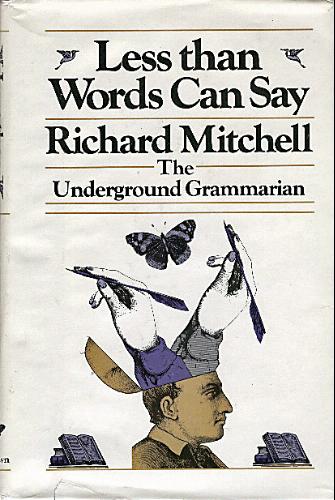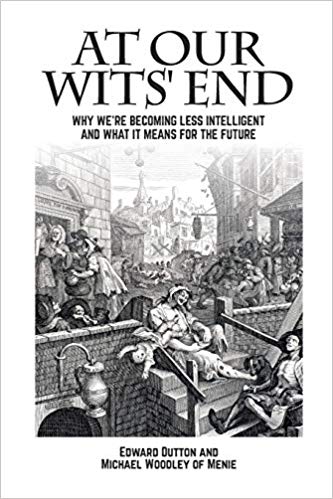Ryan Reeves
Published on 2 Jul 2014The 100 Years War between France and England lasted more than 100 years and was not one war but many. We explore Henry V and other important kings, and finish by exploring Joan of Arc as the savior of France.
Ryan M. Reeves (PhD Cambridge) is Assistant Professor of Historical Theology at Gordon-Conwell Theological Seminary.
Twitter: https://twitter.com/RyanMReevesWebsite: http://www.gordonconwell.edu/academic…
For the entire course on ‘Church History: Reformation to Modern’, see the playlist: https://www.youtube.com/playlist?list…
June 17, 2019
100 Years War
QotD: Betteridge’s Law of Headlines
This story is a great demonstration of my maxim that any headline which ends in a question mark can be answered by the word “no.” The reason why journalists use that style of headline is that they know the story is probably bullshit, and don’t actually have the sources and facts to back it up, but still want to run it.
Ian Betteridge, “TechCrunch: Irresponsible journalism”, Techechnovia.co.uk, 2009-02-23. (Link goes to archived page at the Wayback Machine.)
June 16, 2019
History of England – Ashes – Extra History – #4
Extra Credits
Published on 15 Jun 2019Bertrand du Guesclin was the hero the French needed. Focused on fortifying defenses and cities, Guesclin rebutted the advances of the Black Prince — who ended up contracting an illness that undid his iconic image of triumph and chivalry. Edward became beset by drama in the royal court, and England started to lose power…
Thanks again to David Crowther for writing AND narrating this series! https://thehistoryofengland.co.uk/pod…
Join us on Patreon! http://bit.ly/EHPatreon
Encountering Richard Mitchell’s Less Than Words Can Say
In Quillette, Mark Andre Alexander recounts his first brush with “The Underground Grammarian”:
My first upper division English class shocked me when a dinosaur English professor, Dr. David Bell — a professor in Richard Mitchell’s mold, but not yet a curmudgeon — gave me my first C on a paper, busting my A-student self-image. That wake-up call helped me to see that, although I was published, I had much to learn about writing. Worse, in my first graduate course, Bell’s “Austen and Bronte,” I discovered that I had much to learn about reading, and that I lacked the acuity to appreciate Jane Austen’s clear, witty, and precise prose.
Not long before, I’d read Richard Mitchell’s first book, Less Than Words Can Say. I don’t recall how I stumbled upon him. I’d probably read some opinion column that referred to his work. In a publication announcement in the Underground Grammarian, Mitchell described it as “a melancholy meditation on the dismal consequences of the new illiteracy.”
He had wanted to title the book The Worm in the Brain, pointing to the dangers of administrative rhetoric. The publisher rejected that title as “too frightening and grisly,” But I knew I had found a fellow traveler when I read his Foreword:
Words never fail. We hear them, we read them; they enter into the mind and become part of us for as long as we shall live. Who speaks reason to his fellow men bestows it upon them. Who mouths inanity disorders thought for all who listen. There must be some minimum allowable dose of inanity beyond which the mind cannot remain reasonable. Irrationality, like buried chemical waste, sooner or later must seep into all the tissues of thought.
With that prophetic book, I first experienced the “cleansing fire [that] leaps from the writings of Richard Mitchell,” as George F. Will later described it.
Mitchell did title the first chapter “The Worm in the Brain,” in which he told the story of a colleague who would send him a note whenever there was some committee meeting. At first the note read something like, “Let’s meet next Monday at two o’clock, OK?” But when he aspired to become assistant dean pro tem, the simple, perfect prose changed. “This is to inform you that there will be a meeting next Monday at 2:00.” After achieving that appointment, the note read, “You are hereby informed that the committee on Memorial Plaques will meet on Monday at 2:00.” The worm in the brain had done its work.
I began to notice the worm in the brain during my everyday interactions with friends and colleagues at the university, especially the English professors. It often took the form of a label which created an image in the brain that prevented thought. One such professor, smart and engaging, returned a paper analyzing a passage in the U.S. Constitution. She gave the paper an A, but added, “I can’t help but feel that your argument is wrong, although I can’t explain why. I showed it to my husband, and he thought that it was a conservative argument.”
That statement invalidated the A, and I experienced my first taste of how subtly an abstract label can paralyze an otherwise thoughtful mind. Years later, while teaching at a business college, I saw a more pronounced form of the same phenomena. During a Business English class, I chatted with a bright student who volunteered for the NAACP. We would discuss all kinds of interesting topics, such as the similarities and differences between Martin Luther King and Malcolm X.
That is, until I noticed a change. She had stopped talking to me like a fellow human being and started talking at me like a white male. I stopped her and asked if she noticed what she had just done. She hadn’t, so I pointed out that she had shifted from talking to me to talking to an image inside her head. I told her that I would hold my hand up and block my face every time she did it. As the conversation proceeded, and I raised my hand, lowered it, and then raised it again, she became aware of the worm in her brain, a mental-emotional implant that prevented her from treating me as a colleague when certain topics were engaged.
Her implant was creating rubbish, of course, but it was insidious by nature because it disguised itself as something in the real world. Worms in the brain are like that.
Britain Votes to Leave – WW2 – 042 – June 15 1940
World War Two
Published on 15 Jun 2019The fighting in France isn’t over, not even when Paris falls, as the Germans advance and Italy joins the fight. But the Brits now have their back to yet another ocean and see no option but out. Further east Stalin uses the chaos in the West as cover to start moving in on his neighbours.
Join us on Patreon: https://www.patreon.com/TimeGhostHistory
Or join The TimeGhost Army directly at: https://timeghost.tvFollow WW2 day by day on Instagram @World_war_two_realtime https://www.instagram.com/world_war_t…
Join our Discord Server: https://discord.gg/D6D2aYN.
Between 2 Wars: https://www.youtube.com/playlist?list…
Source list: http://bit.ly/WW2sourcesWritten and Hosted by: Indy Neidell
Produced and Directed by: Spartacus Olsson and Astrid Deinhard
Executive Producers: Bodo Rittenauer, Astrid Deinhard, Indy Neidell, Spartacus Olsson
Creative Producer: Joram Appel
Research by: Indy Neidell
Post Production Director: Wieke Kapteijns
Edited by: Marek Kamiński
Map animations: EastoryColorisations by Norman Stewart and Julius Jääskeläinen https://www.facebook.com/JJcolorization/
Eastory’s channel: https://www.youtube.com/channel/UCEly…
Archive by Screenocean/Reuters https://www.screenocean.com.Sources: Italo-Scottish Research Cluster, Alchemist-hp
A TimeGhost chronological documentary produced by OnLion Entertainment GmbH.
From the comments:
World War Two
2 days ago
Paris… German soldiers in 1914 left their homes for the western front painted “To Paris” on their train carriages, little did they know what horrors were awaiting them. And that after four years of fighting in the trenches, none of them made it to Paris. This week, after another month of fighting in France, they finally do.Whenever we read that some of you think that it’s just Indy making all of this, we have a good laugh. Actually, there are over 10 people working on this project. We have multiple editors, researchers/historians, producers, fact-checkers, colorisers and volunteers working on this. And of course there’s Eastory making the maps. We’d like to pay each and everyone of them for their hard work so they can feed themselves. Truth is, many of them work on a voluntary or part-time basis right now. The support we get on Patreon and our website is great and helps us sustain this channel, but we’re not nearly at the point that everyone involved gets what they deserve. If you like our work here on YouTube and you want to support the people who make it, please check us out on https://www.patreon.com/TimeGhostHistory or on our website https://timeghost.tv. Help us make history! Every dollar counts!
Cheers,
Joram
The “NBA” unveiled
Just before his mysterious disappearance (police are baffled, no clues have been found, etc., etc.), Colby Cosh filed a bizzare rant with his newspaper that they somehow forgot to spike:

Kawhi Leonard of the Toronto Raptors about to attempt a free throw during game 2 of the 2019 NBA Finals.
Photo by Chensiyuan via Wikimedia Commons.
By the time you read this, I may be dead. The newspaper industry’s taboo against openly discussing the scriptwriters who create the elaborate soap operas we call “professional sports” is a strong one, and viciously enforced. The money we make from pretending that sports aren’t fake is too important to our bottom line. Good people who have tried to write articles like this have found their careers and lives cut short.
No doubt it will be so with me, but I feel that the geniuses behind the “National Basketball Association” — rumoured to be a tight-knit group of a half-dozen or so fiction veterans recruited from Hollywood, the manga industry, and, in at least one case, Harlequin Enterprises Ltd. — deserve credit. Decades of planning went into this ambitious, implausible Toronto Raptors story line. The conquest of Canada now seems complete.
For decades no one thought that basketball, as a theatrical production, could make headway in Canada against the National Hockey League. The NHL’s scriptwriters were thought to be too naturally, intuitively in touch with Canada’s Victorian and Protestant values. And Canada, owing to its geography, had a natural market corner on “athletic” performers who could skate. The league could always come up with a backstory and an affable personality for a “Wayne Gretzky” (actually a figure skater from Swift Current named Kevin Feinberg) or “Alexander Ovechkin” (born Dennis Brian York in Nepean, Ont.)
Unfortunately, the NHL, its creative staff increasingly laden with third- and fourth-generation mediocrities, started to spin its wheels as any monopolistic institution does in the end. It became the CBC of sports. Head showrunner Gary Bettman adopted an ambitious strategy of colonizing new American markets, but failed to bring new blood into the writing room. He was left with increasingly cheap, desperate moves like inventing the “Vegas Golden Knights” and injecting them directly into the Stanley Cup final.
Accounts of when and how the so-called “National Basketball Association” decided to exploit this weakness remain cloudy. They say one of the writers was thumbing through the sport’s “bible,” the binder every television program keeps on hand to guarantee continuity, and noticed that basketball’s creation myth actually involves a Canadian inventor-hero, “James A. Naismith.” (This has always invited suspicion among the punters. How many Naismiths do you run across?)
Finnish Bofors 37mm anti-tank gun
Forgotten Weapons
Published on 27 Apr 2014Cool Forgotten Weapons Merch! http://shop.bbtv.com/collections/forg…
Theme music by Dylan Benson – http://dbproductioncompany.webs.com
The Swedish Bofors company developed a sophisticated and very high-quality light anti-tank gun in the early 1930s, and found significant commercial success with it. A variety of countries either purchased the guns outright from Bofors or paid for licenses to produce them domestically. These countries included Denmark, Finland, Poland, the Netherlands, and Sweden itself. The largest number were in Poland (1200 or more), and there is speculation that some may have been sold to Spain during the Spanish Civil War (both these guns and a 40mm AA gun which definitely went to Spain were designated wz.36). A significant number were also captured and reused by German and Russian forces during WWII. On the Allied side, some of the guns were sold to the Sudan and used by British forces in North Africa (generally mounted on trucks).
The gun itself was an excellent design, capable of 12 rounds/minute of accurate fire and potent enough to deal with most of the smaller tanks in existence at the beginning of WWII. New tank developments made it obsolete, but it was at least effective against Russian light tanks (BT, T-26, T-28) in the Winter War if not the heavier T-34s. The gun has a sophisticated suspension system to help absorb recoil energy, and fired a 37 x 257mm shell with a 740g projectile at about 825 m/s (26oz @ 2700 fps). The action was semi-automatic, meaning that once fired, the action would recoil on the carriage, and automatically eject the empty case. It would then return to battery with the breech open, ready for a new shell to be loaded (in the video, the ejection mechanism has been disabled to help preserve the brass cases).
QotD: Critical gender studies
The first thing you must understand is that gender is a social construct. “Woman” and “man” are concepts arbitrarily invented by society. They have nothing to do with reality. A child is assigned one of these labels randomly at birth by primitive, backward-thinking doctors who, for no good or objective reason, have decided that a human child with a penis must be a boy and a human child with a vagina must be a girl. These words are all interchangeable, as are the body parts. None of it means anything, really.
But remember that the generic people we meaninglessly call “women” are beautiful and powerful and their arbitrary womanhood should be constantly celebrated. Women must band together and lift each other up. Women must be represented equally in all of our institutions. Women are truly wonderful, splendid, special creatures.
But there is nothing special about women. Literally anyone can be a woman. A woman is not anything in particular. A person with a penis can be a woman. A person with a vagina can be a woman. If a bucket of sand came to life and wanted to be a woman, it could be a woman. There is no aspect of womanhood that is ingrained or biological or inaccessible to males. And womanhood certainly has nothing at all to do with your body parts.
But if you don’t have a uterus then you shouldn’t be giving your opinion on women’s rights. No uterus, no opinion. That’s the motto. We’re tired of men making decisions about women’s bodies.
But there is no such thing as a woman’s body. Transwomen are women, too. A transwoman is just a much a woman as any other woman. There is absolutely no difference between the two and to suggest otherwise is the height of bigotry.
Matt Walsh, “Explaining Progressive Gender Theory To Right Wing Bigots”, The Daily Wire, 2019-05-14.
June 15, 2019
Miscellaneous Myths: Io
Overly Sarcastic Productions
Published on 14 Jun 2019The moon! The myth! The legend! The three millionth woman to live through an absolute nightmare just because Zeus couldn’t be bothered to keep it in his pants!
Still had a better life than Callisto, though.
Pro tip, if someone is listed on wikipedia as a “lover” of zeus, that does not at all indicate that their relationship was consensual.
PATREON: https://www.Patreon.com/OSP
13-0
The US Women’s national soccer team eviscerated Thailand by an unheard-of 13-0 score in the group stage of the FIFA Women’s World Cup. It was not a great day for sportsmanship, as the American women celebrated every goal as if they’d just broken a 0-0 tie in injury time of the final:

A screen capture from the highlight video at YouTube. Amusingly, if you try to watch this clip on the official FIFA Women’s World Cup site, you get an error saying “This video contains content from FIFA, who has blocked it from display on this website”
At American Thinker, Jonathan Keiler recounts the reaction to the game and the counter-reaction that followed:
On Tuesday the U.S. Women’s National (soccer) Team (WNT) obliterated a hapless Thailand squad in a 13-0 rout. That’s about 91-0 in football terms, but in a sense even worse, given soccer’s relative dearth of scoring. It would not be worth noting, except that many present and former WNT players recently sued the U.S. Soccer Federation claiming disparate treatment and pay, and to the general championing of all things female in a supposed age of “toxic masculinity.”
The game and the result might cause a reasonable observer to question popular progressive views on these issues, not because the U.S. women won, but how they did it.
[…]
This lack of competitive edge to the women’s game affects it at all levels, from youth leagues to international soccer. It’s not the individual players’ fault, but it’s a fact. I coached soccer for years (boys and girls.) On the women/girls side, routs like what happened on Tuesday are relatively commonplace in many leagues, up to and including high school — and obviously even after. And while this happens on the boys/men’s side too, it is less common and exaggerated.
So even leaving aside the issue of whether the men’s game is better in terms of speed/skill/aggression, the fact is generally the men’s game is more interesting and competitive more often. That puts additional fannies in seats, people watching on TV, and generates greater income, which is reflected in pay. Non-soccer aficionados may pooh-pooh the game’s rhythms and low scoring generally, but the fact is, first round games in the Men’s World Cup are far more interesting and exciting than the female version. So the WNT did themselves no favor in their legal case by making a major shortcoming of the women’s game painfully obvious.
They also did themselves no favors winning over international fans (and a lot of on-the-fence Americans) by their graceless destruction of the Thailand ladies. It’s not just that the WNT ran up the score, it’s that as they did so they acted as if they were heroes doing the impossible, rather than seasoned pros essentially carving up an amateur squad. They screamed, danced, ran around crazily, slid on the ground and the like, after every one of those thirteen goals. They didn’t act like children — they acted worse than children.
Just Peace Or Day of Dishonor? – The Treaty of Versailles I THE GREAT WAR June 1919
The Great War
Published on 14 Jun 2019Support us on Patreon and get an actual WW1 postcard signed by the team: http://patreon.com/thegreatwar
The Treaty of Versailles was the first of the big peace treaties after the armistice of 1918. In just six months the allied powers had – without talking to the defeated powers – negotiated a new world order while trying to make sure Germany would pay reparations to rebuild. The German delegation was only informed about the peace terms a few weeks before signing the Treaty and they were shocked about the terms. In May 1919 they even considered not signing the contract at all.
» SUPPORT THE CHANNEL
Patreon: https://www.patreon.com/thegreatwar
Merchandise: https://shop.spreadshirt.de/thegreatwar/» SOURCES
Gerwarth, Robert. The Vanquished. Why the First World War Failed to End, 1917-1923 (Penguin, 2017).Leonhard, Jörn. Der überforderte Frieden. Versailles und die Welt 1918-1923 (CH Beck, 2018)
Macmillan, Margaret. The Peacemakers: Six Months that Changed the World (London: John Murray, 2001).
Sharp, Alan. The Versailles Settlement. Peacemaking after the First World War, 1919-1923 (Basingstoke: Palgrave MacMillan, 2008).
Stevenson, David. 1914-1918 (London: Penguin, 2012).
Winter, Jay and Antoine Prost. The Great War in History (Cambridge: Cambridge University Press, 2008).Hobsbawm, Eric. Age of Extremes. The Short Twentieth Century 1914-1991 (Abacus, 1994).
http://www.ataa.org/reference/iacom.pdfhttp://germanhistorydocs.ghi-dc.org/p… quoting:
Philipp Scheidemann, “Gegen die Annahme des Versailler Vertrages 12. Mai 1919”, Politische Reden III, herausgegeben von Peter Wende. Deutscher Klassiker Verlag:Frankfurt am Main, 1994, S.254-62»CREDITS
Presented by: Jesse Alexander
Written by: Jesse Alexander
Director: Toni Steller & Florian Wittig
Director of Photography: Toni Steller
Sound: Toni Steller Editing: Toni Steller
Mixing, Mastering & Sound Design: http://above-zero.com
Motion Design: Christian Graef – GRAEFX
Maps: Daniel Kogosov (https://www.patreon.com/Zalezsky)
Research by: Jesse Alexander
Fact checking: Florian WittigChannel Design: Alexander Clark
Original Logo: David van StepholdA Mediakraft Networks Original Channel
Contains licensed material by getty images
All rights reserved – Real Time History GmbH 2019
The real explanation for our lack of moonbases/Concorde 2’s/great walls/pyramids
Homoitalicus Blog responds to a new book [At Our Wit’s End by Edward Dutton and Michael Woodley of Menie] that concludes that we (western civilization) are headed toward a similar fate as the western Roman Empire:
The reason that these staggering feats of engineering haven’t been repeated is more to do with economics and politics than with any perceived lack of engineering Genius in the population. The authors fail to reflect that emerging from the massively centralised wartime economy of the West there was an enormous technological infrastructure of scientists and capable administrators just sat there with no more Nazis to fight, communist megalomaniacs to support, Atom bombs to build and test, or greatest seabourne invasions in history to plan and implement.
This was probably the greatest concentration of intellect ever harnessed to a single cause and hopefully we’ll never need to see its like again
With the war done and dusted some new purpose needed to be found for all this talent, the way of government being what it is, returning all these geniuses to normal boring peacetime activity was never an option.
Newly nationalised aircraft industries took the wartime inventions of jet engine and the rest and evolved them with massive amounts of financial input from the government into Concorde, truly a magnificent aircraft but one which could uncharitably be described as using taxpayers’ money to ferry plutocrats from one side of the Atlantic to the other. Whether it ever really paid for itself is a moot point and the unseemly haste with which it was dumped after the crash tends to imply that its 50-year-old airframes were becoming a burden, and the economic case for making a new generation of supersonic planes is weak – luckily the will in the west for another taxpayer-funded effort doesn’t seem to be there. That is progress.
Likewise the man on the moon, possible only because of the Cold War space race.
The authors might as well explain the fact that we haven’t build another pyramid of Giza or Great Wall of China.
Their assertion that a general decline in the amount of creativity (which is correlated strongly with g) is justified by the observable decline in the quality of the output of the BBC. However other possible reasons for this are the infestation of Cultural Marxism and its baleful handmaid, Political Correctness, which really mitigate against creative thought. It is impossible to imagine making The Life of Brian, or The Sweeney or countless other shows which we enjoyed in our youth nowadays largely for reasons of PC and the fact that the BBC’s mission is now brainwashing rather than entertainment. State broadcasters the world over will suffer from the same problem, as does (worryingly) the world of academe in which speakers of truth or opinion which lie outwith accepted and very tightly bounded acceptability, are routinely no-platformed or summarily sacked. The teaching of history and the humanities generally has been debased, and only the STEM subjects seem to have resisted (excluding the question of Climate Change which has taken on the trappings of a religion rather than serious science).
As a consequence it is impossible to separate the effects of CM from the mooted results of a generalised decline in intelligence, and the authors are wrong not to point this out.
They don’t consider either the likely effect of the 20th century’s great blood letting in the fields of Flanders. A substantial proportion of the best and brightest of a generation were ground into the mud there before being able to procreate. I would be surprised if that had no effect on the quality of the gene pool.
H/T to the Continental Telegraph for the link.
Hand tools for $100 #2: Buying the planes you really need.
Rex Krueger
Published on 7 Apr 2017More videos and exclusive content: http://www.patreon.com/rexkrueger
You can buy 50 vintage hand-planes and spend the next year restoring them, or you can get three common and useful planes and get to work right now. In this video, I’ll show you the three planes that you will use for 80% of your woodworking even once you become a more experienced craftsman. These planes are common, easy to find, and generally cheap. They each have a specific and important function in the shop. Once you own these models, your ability to process stock in a clean and quiet environment will amaze you. You can always buy expensive machines later, but with good planes, you can get working immediately.
QotD: The early Bauhaus
The ideas of the modernists were generally expressed in the imperative mood and were frequently of a pseudo-mystical nature. Professor Curl’s description of some of the practices prevalent in the early Bauhaus make for hilarity; cranks are always a source of fun. In the early days, the modernists of the Bauhaus tended to a form of health mysticism involving vegetarianism, garlic paste, and regular enemas. Far more important, however, was their early and inherent attraction to totalitarianism. As the author points out, Gropius and Miës van der Rohe had no objection to Nazism other than that the Nazis failed to commission work from them. Gropius was an opportunistic anti-Semitic snob who espoused communism until it was no longer convenient for his career. Miës sucked up to the Nazis as much as he was able. The fact that both of them emigrated from Germany has done much to obscure their accommodation with the Nazis and even allowed the modernists to pose as anti-Nazi — though the most important proponent of modernism in America, Philip Johnson, had for some years been a rank Nazi in more than merely nominal terms. Moreover, as Professor Curl points out, the Nazi aesthetic, like the communist, had much in common with modernism.
Theodore Dalrymple, “Crimes in Concrete”, First Things, 2019-06.
June 14, 2019
Eliminating the trade deficit
A few weeks back, Robert Higgs explained why President Trump’s concerns about the trade deficit are, at best, misplaced and how “fixing” it would lead to a much worse situation:

Donald Trump addresses a rally in Nashville, TN in March 2017.
Photo released by the Office of the President of the United States via Wikimedia Commons.
So, let’s consider the president’s trade policy in, as it were, its very best light. Suppose, then, that the government succeeded in eliminating the trade deficit entirely. Residents of the USA would continue to sell huge quantities of goods to foreigners but buy nothing at all from foreign sellers. The trade deficit would be not only diminished but wiped out and replaced by a huge trade surplus. Trumpian triumph!
Note, however, that such an outcome would be impossible to sustain for long even if it could be attained (which in fact it could not). Foreigners would be spending huge quantities of dollars to purchase goods from Americans, but they would have no means of earning dollars because Americans would not be buying anything from them. Foreigners could continue to make such purchases only if they received dollar credits from foreigners. But lenders would have no incentive to lend dollars to the Chinese, say, when they knew that the Chinese would have no ability to repay the loans because they would have no means of earning dollars in the future by sales to Americans. So a big U.S. trade surplus requires that totally implausible assumptions be made about international transactions in general and international lending in particular.
But apart from such practical difficulties and impossibilities, a Trumpian trade triumph, even if it could be achieved, would be a horrible objective to attain. Americans would be employing labor services, natural resources, and other productive inputs to produce goods and shipping them to foreign buyers. In exchange, they would receive nothing but bank account balances. Such a deal! Surrendering huge volumes of valuable goods and receiving in return larger numerals in people’s bank account statements, more dollars that could not be used to purchase anything, no matter how important or desirable, from abroad — all such purchases having somehow been stopped by a harebrained government and the economic ignoramus in charge of it.












